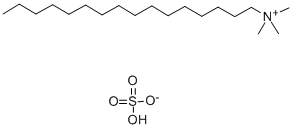Hexadecyl trimethyl ammonium bromide
Synonym(s):Cetrimonium bromide;Cetyltrimethylammonium bromide;CTAB;Hexadecyltrimethylammonium bromide;Palmityltrimethylammonium bromide
- CAS NO.:57-09-0
- Empirical Formula: C19H42BrN
- Molecular Weight: 364.45
- MDL number: MFCD00011772
- EINECS: 200-311-3
- SAFETY DATA SHEET (SDS)
- Update Date: 2025-12-29 14:06:09

What is Hexadecyl trimethyl ammonium bromide?
Description
Cetyltrimethylammonium bromide (CTAB), sometimes called cetrimonium bromide, is a quaternary ammonium salt with surface-active and antiseptic properties. Today, in addition to its use as a topical antiseptic, CTAB has applications in medicine as an apoptosis-promoting anticancer agent, and in protein electrophoresis, DNA extraction buffer systems, and nanoparticle synthesis.
Chemical properties
White powder. Soluble in water, alcohol, and chloroform.
Definition
ChEBI: The organic bromide salt that is the bromide salt of cetyltrimethylammonium; one of the components of the topical antiseptic cetrimide.
What are the applications of Application
Cetrimonium bromide is a quaternary ammonium salt that can prevent the proliferation of bacteria, fungi, and yeast in cosmetic preparation, while also act as an emulsifying agent. It is a cationic surfactant used as a template in the synthesis of Mesoporous γ-Fe2O3.
Biochem/physiol Actions
Hexadecyltrimethylammonium bromide also called cetyltrimethylammonium bromide (CTAB), is a cationic surfactant. CTAB is employed for extraction of DNA. CTAB method is efficient, cost and time effective for DNA extraction. CTAB is used as a shaping material and reducing agent for nanoparticle generation.
Purification Methods
Crystallise it from EtOH, EtOH/*benzene or from wet acetone after extracting twice with pet ether. Shake it with anhydrous diethyl ether, filter and dissolve it in a little hot MeOH. After cooling in the refrigerator, the precipitate is filtered off at room temperature and re-dissolved in MeOH. Anhydrous ether is added and, after warming to obtain a clear solution, it is cooled and the crystalline material is collected. [Dearden & Wooley J Phys Chem 91 2404 1987, Hakemi et al. J Am Chem Soc 91 120 1987, Beilstein 4 IV 819.]
References
[1] Liu, Tingting et al. “Hexadecyl trimethyl ammonium bromide assisted growth of NiCo2O4@reduced graphene oxide/ nickel foam nanoneedle arrays with enhanced performance for supercapacitor electrodes?.” RSC Advances 7 (2022): 4029–4041.
Properties of Hexadecyl trimethyl ammonium bromide
| Melting point: | 248-251 °C(lit.) |
| Density | 1.1107 (rough estimate) |
| refractive index | 1.5260 (estimate) |
| Flash point: | 244 °C |
| storage temp. | Store below +30°C. |
| solubility | H2O: 50 mg/mL |
| form | powder |
| appearance | white crystals or powder |
| color | white |
| Odor | Odorless |
| PH | 5.0-7.0 (25℃, 0.1M in H2O) |
| PH Range | 5 - 7 |
| Water Solubility | 13 g/L (20 ºC) |
| Sensitive | Hygroscopic |
| λmax | λ: 260 nm Amax: 0.06 λ: 280 nm Amax: 0.05 |
| Merck | 14,2025 |
| BRN | 3598189 |
| Stability: | Stable. Incompatible with strong oxidizing agents. Protect from moisture. |
| CAS DataBase Reference | 57-09-0(CAS DataBase Reference) |
| EPA Substance Registry System | Cetyl trimethyl ammonium bromide (57-09-0) |
Safety information for Hexadecyl trimethyl ammonium bromide
| Signal word | Danger |
| Pictogram(s) |
 Corrosion Corrosives GHS05  Exclamation Mark Irritant GHS07  Health Hazard GHS08  Environment GHS09 |
| GHS Hazard Statements |
H302:Acute toxicity,oral H315:Skin corrosion/irritation H318:Serious eye damage/eye irritation H335:Specific target organ toxicity, single exposure;Respiratory tract irritation H373:Specific target organ toxicity, repeated exposure H410:Hazardous to the aquatic environment, long-term hazard |
| Precautionary Statement Codes |
P273:Avoid release to the environment. P280:Wear protective gloves/protective clothing/eye protection/face protection. P314:Get medical advice/attention if you feel unwell. P301+P312:IF SWALLOWED: call a POISON CENTER or doctor/physician IF you feel unwell. P302+P352:IF ON SKIN: wash with plenty of soap and water. P305+P351+P338:IF IN EYES: Rinse cautiously with water for several minutes. Remove contact lenses, if present and easy to do. Continuerinsing. |
Computed Descriptors for Hexadecyl trimethyl ammonium bromide
| InChIKey | LZZYPRNAOMGNLH-UHFFFAOYSA-M |
Hexadecyl trimethyl ammonium bromide manufacturer
JSK Chemicals
New Products
4,4-Difluoropiperidine hydrochloride tert-butyl 9-methoxy-3-azaspiro[5.5]undecane-3-carboxylate Indole Methyl Resin N-Isopropylurea N,N-Dicyclohexylcarbodiimide(DCC) MELDRUMS ACID 5-METHYLISOXAZOLE-4-CARBOXYLIC ACID Magnessium Bis glycinate Zinc ascorbate 1-bromo-2-butyne 2-acetamidophenol 9(10H)-anthracenone Erythrosin B, 4-Piperidinopiperidine 2-((4-morpholinophenylamino) (methylthio) methylene) malononitrile 2,4-dihydroxybenzaldehyde 3-(4-morpholinophenylamino)-5-amino-1H-pyrazole-4-carbonitrile Methyl 2-methylquinoline-6-carboxylate 2,6-dichloro-4-nitropyridine 4-Bromo-2-chlorobenzonitrile 2-(benzylamino)acetic acid hydrochloride 4-(tert-Butoxycarbonylamino)but- 2-ynoic acid 3,4-dihydro-2H-benzo[b][1,4]dioxepine 1-Phenyl-1-cycloprppanecarboxylicacidRelated products of tetrahydrofuran








You may like
-
 Cetyltrimethylammonium bromide, 98% 98%View Details
Cetyltrimethylammonium bromide, 98% 98%View Details
57-09-0 -
 Cetyl Trimethyl Ammonium Bromide 57-09-0 99%View Details
Cetyl Trimethyl Ammonium Bromide 57-09-0 99%View Details
57-09-0 -
 Cetrimide (SQ) CAS 57-09-0View Details
Cetrimide (SQ) CAS 57-09-0View Details
57-09-0 -
 Cetyltrimethyl Ammonium Bromide (CTAB) extrapure AR CAS 57-09-0View Details
Cetyltrimethyl Ammonium Bromide (CTAB) extrapure AR CAS 57-09-0View Details
57-09-0 -
 Cetyltrimethyl Ammonium Bromide (CTAB) for cell culture CAS 57-09-0View Details
Cetyltrimethyl Ammonium Bromide (CTAB) for cell culture CAS 57-09-0View Details
57-09-0 -
 n-Cetyl n,n,n,tri methyl ammonium bromide CAS 57-09-0View Details
n-Cetyl n,n,n,tri methyl ammonium bromide CAS 57-09-0View Details
57-09-0 -
 N-Cetyl-N,N,N-trimethyl ammonium bromide 99% CAS 57-09-0View Details
N-Cetyl-N,N,N-trimethyl ammonium bromide 99% CAS 57-09-0View Details
57-09-0 -
 CETYL TRIMETHYL AMMONIUM BROMIDEView Details
CETYL TRIMETHYL AMMONIUM BROMIDEView Details
57-09-0
